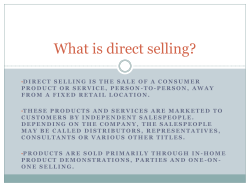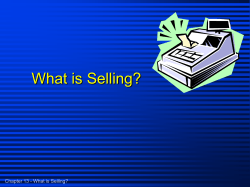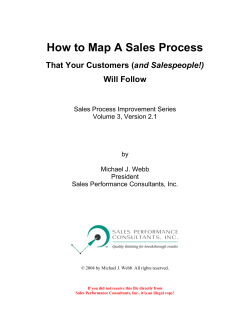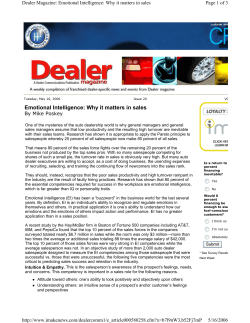
Copyright © 2001 by Harcourt, Inc. All rights reserved.
Copyright © 2001 by Harcourt, Inc. All rights reserved. PART V DIRECTING THE SALES TEAM Copyright © 2001 by Harcourt, Inc. All rights reserved. CHAPTER 12 MOTIVATING SALESPEOPLE TOWARD HIGH PERFORMANCE Copyright © 2001 by Harcourt, Inc. All rights reserved. LEARNING OBJECTIVES An enthusiastic and motivated sales force is the best possible foundation for successful achievement of sales objectives. This chapter should help you understand: That the definition of motivation includes the motivational mix and all of its various elements. The powerful motivating influence of a high-performance sales culture. The importance of realizing that salespeople have basic needs that, when met are strongly motivating. The model for a salesperson’s behavior. The benefit of knowing salespeople personally. That not every member of a sales force can be motivated. Copyright © 2001 by Harcourt, Inc. All rights reserved. MOTIVATION The components of a motivational system: • Understand what motivation is all about. • Develop a high-performance sales culture. • Know salespeople’s basic needs. • Realize that salespeople want to know what is in it for them. Copyright © 2001 by Harcourt, Inc. All rights reserved. The components of a motivational system: continued • Get to know the personal side of salespersons. • Always remember that motivational coaching is needed for high performance. •Be realistic about motivating salespeople. Copyright © 2001 by Harcourt, Inc. All rights reserved. UNDERSTAND WHAT MOTIVATION IS ALL ABOUT In any discussion about the motivation of salespeople, the following four questions need to be considered: • What arouses salespeople’s behavior? • What influences the intensity of the behavioral arousal? • What directs the person’s behavior? • How is this behavior maintained over time? Copyright © 2001 by Harcourt, Inc. All rights reserved. Motivation refers to the arousal, intensity, direction, and persistence of effort directed toward job tasks over a period of time. Copyright © 2001 by Harcourt, Inc. All rights reserved. THE SALES MOTIVATIONAL MIX Motivational Mix – The arousal, intensity, direction, and persistence of people’s behavior. Extrinsic Outcomes – Rewards obtained from individuals’ environment. Intrinsic Outcomes – Occur purely from the performance of the task itself. Copyright © 2001 by Harcourt, Inc. All rights reserved. TABLE 12.1 THE SEVEN COMPONENTS OF THE SALES MOTIVATIONAL MIX AND EXAMPLES OF EACH MOTIVATIONAL METHOD 1. 2. 3. 4. Sales culture Ceremonies and rites Stories Symbols Language Basic compensation Salary Commissions Fringe benefits Special financial incentives Bonuses Contests Trips Nonfinancial rewards Opportunity for promotion 5. 6. 7. Challenging work assignments Recognition Sales Training Initial Ongoing Sales meetings Leadership Style Personal contacts Performance evaluation Method Performance Activity Publicity Copyright © 2001 by Harcourt, Inc. All rights reserved. DEVELOP A SALES CULTURE Sales culture refers to a set of key values, ideas, beliefs, attitudes, customs, and other capabilities and habits shared or acquired as a member of the sales group. Copyright © 2001 by Harcourt, Inc. All rights reserved. IMPLEMENTATION OF A SALES CULTURE • Ceremonies and Rites Copyright © 2001 by Harcourt, Inc. All rights reserved. Ceremonies and rites are the elaborate, planned activities that make up a special event and often are conducted for the benefit of an audience. Copyright © 2001 by Harcourt, Inc. All rights reserved. IMPLEMENTATION OF A SALES CULTURE • Ceremonies and Rites • Stories Copyright © 2001 by Harcourt, Inc. All rights reserved. Stories are narratives based on true events that are frequently shared among salespeople and told to new sales reps to inform them about the organization. Copyright © 2001 by Harcourt, Inc. All rights reserved. IMPLEMENTATION OF A SALES CULTURE • Ceremonies and Rites • Stories • Symbols Copyright © 2001 by Harcourt, Inc. All rights reserved. A symbol is one thing that represents another thing. Copyright © 2001 by Harcourt, Inc. All rights reserved. IMPLEMENTATION OF A SALES CULTURE • Ceremonies and Rites • Stories • Symbols • Language Copyright © 2001 by Harcourt, Inc. All rights reserved. Many companies use a specific saying, slogan, metaphor, or other language form to convey special meaning to employees. Copyright © 2001 by Harcourt, Inc. All rights reserved. TABLE 12.2 EXAMPLES OF CULTURAL VALUES AND BELIEFS AND THEIR IMPLEMENTATION WITHIN THE SALES FORCE CULTURE Shared Values Reward for performance Customer service at any cost Employees are part of family Attain sales targets Shared Beliefs Customer orientation We like this company We are a team The company cares about us Quality work life We are professionals IMPLEMENTING CULTURE Shared Ceremonies Annual awards for meritorious customer service Monthly meetings to acknowledge people who attain 100% of sales targets Shared Stories Sales managers who make salespeople successful; help with personal problems Heroic efforts to please customers by legendary salespeople Shared Symbols and Slogans "Build bridges" to be in touch with customers. "We don't stand on rank" (equality of family.) Open offices for easy communication Special plaques for customer service and sales leaders Copyright © 2001 by Harcourt, Inc. All rights reserved. WHAT’S IN IT FOR ME? Expectancy theory is based on the assumption that salespeople have expectancies about what they should receive from their employer as a result of their work efforts. Copyright © 2001 by Harcourt, Inc. All rights reserved. WHAT IS THE PROBABILITY OF SUCCESS? Expectancy is the salesperson’s estimate of the probability that expending a given amount of effort on a task will lead to an improved level of performance on some dimension. Copyright © 2001 by Harcourt, Inc. All rights reserved. FIGURE 12.1 FOUR QUESTIONS SALESPEOPLE ASK TO DETERMINE HOW MUCH EFFORT THEY WILL DEVOTE TO THEIR JOBS. “What Is the Probability of Success?” Motivation to Work “Will I Be Rewarded for Success?” Performance Level “Are the Rewards Worth It?” Rewards Intrinsic Extrinsic Equity Determination Inputs vs. Outputs Feedback Copyright © 2001 by Harcourt, Inc. All rights reserved. “Are the Rewards Fair?” Satisfaction Intrinsic Extrinsic WILL I BE REWARDED FOR SUCCESS? The salesperson’s estimate of the probability that achieving an improved level of performance dimension will lead to increased attainment of a particular reward or outcome may be defined as instrumentality. Copyright © 2001 by Harcourt, Inc. All rights reserved. ARE THE REWARDS WORTH IT? Valence for rewards refers to the value the salesperson places on the reward. Copyright © 2001 by Harcourt, Inc. All rights reserved. Managerial Implications of Expectancy Theory 1. Increase expectancies. 2. Make performance instrumental toward positive outcomes. 3. Identify positively valent outcomes. Copyright © 2001 by Harcourt, Inc. All rights reserved. ARE THE REWARDS FAIR? If inequity is perceived, the salesperson may be motivated to restore equity using one of four methods. • First, the salesperson may increase or decrease the level of input that may, in turn, influence outcomes. • Second, the salesperson could distort the facts by convincing himself or herself that equity really does exist even though it may not. Copyright © 2001 by Harcourt, Inc. All rights reserved. If inequity is perceived, the salesperson may be motivated to restore equity using one of four methods. continued • Third, the salesperson could choose another salesperson with whom to compare the ratio of outcomes to inputs. • Fourth, the salesperson could influence other salespeople to decrease the amount of effort they are putting into their job. Copyright © 2001 by Harcourt, Inc. All rights reserved. HOW TO FACILITATE EQUITY An individual will tend to reduce the level of effort if one of these situations is encountered. 1. Sales performance did not increase. 2. No important rewards were given for meeting quota. 3. The rewards given for meeting quota were not worth the extra work. 4. Treatment was not fair because one person’s rewards were the same as another’s who worked harder. Copyright © 2001 by Harcourt, Inc. All rights reserved. Job Satisfaction and Work Attitudes Job satisfaction refers to feelings toward the job. Job dissatisfaction, aggregated across many individuals, creates a sales force that is more likely to exhibit: 1. Higher turnover. 2. Higher absenteeism. 3. Lower corporate citizenship. 4. More grievances and lawsuits. 5. Stealing, sabotage, and vandalism. 6. Poorer mental and physical health. Copyright © 2001 by Harcourt, Inc. All rights reserved. Quality of Work Life Categories: 1. Adequate and fair compensation. 2. A safe and healthy environment. 3. Jobs that develop human capacities. 4. A chance for personal growth and security. 5. A social environment that fosters personal identity, freedom from prejudice, a sense of community, and upward mobility. Copyright © 2001 by Harcourt, Inc. All rights reserved. Quality of Work Life continued 6. Constitutionalism, or the rights of personal privacy, dissent, and due process. 7. A work role that minimizes infringement on personal leisure and family needs. 8. Socially responsible organizational actions. Copyright © 2001 by Harcourt, Inc. All rights reserved. The term productivity as applied by QWL advocates means much more than each person’s quantity of work output. It also includes: • Levels of turnover • Absenteeism • Accidents • Thefts • Sabotage • Creativity • Innovation • Quality of work Copyright © 2001 by Harcourt, Inc. All rights reserved. Voluntary Turnover Turnover refers to someone leaving their present job. Copyright © 2001 by Harcourt, Inc. All rights reserved. FIGURE 12.2 CLASSIFICATION OF TURNOVER T e r m i n a t i o n s V o l u n t a r y N o n v o l u n t a r y D e s i r a b l e U n d e s i r a b l e ( l o w p e r f o r m e r )( h i g h p e r f o r m e r ) Controllable Uncontrollable Copyright © 2001 by Harcourt, Inc. All rights reserved. FIGURE 12.3 A SALESPERSON’S BEHAVIORAL MODEL HELPS ILLUSTRATE MOTIVATIONAL PROCESS .9 tsaP secneirepxe .1 - n ori v n E l at n e m sr ot c a F .2 - i n a gr O l a n oi t a Z sr otc a F .4 noitavitoM krowot .5 -r ofr e P ec na m leve L .6 sdraweR cisnirtnI cisnirtxE .7 yt i u q E - r et e D n oi t a ni m .8 noitcafsitaS cisnirtnI cisnirtxE .3 lanosreP srotcaF tsaP secneirepxe Copyright © 2001 by Harcourt, Inc. All rights reserved. .01 boJ hcraeS .11 yratnulo V revonruT GET TO KNOW THE PERSONAL SIDE OF SALESPERSONS! UNDERSTAND THE SALESPERSON’S MOTIVATIONAL BEHAVIOR Copyright © 2001 by Harcourt, Inc. All rights reserved. MATCH PEOPLE’S MOTIVES WITH INCENTIVES THEY VALUE Incentives are aspects of the environment that appeal to the salesperson’s motives and have enough worth to motivate purposeful behavior to obtain them. Copyright © 2001 by Harcourt, Inc. All rights reserved. Incentives that motivate people to do their best are high motivators. Examples of high motivators: • Rewards for successes • Recognition for achievement • Job advancement • Freedom to manage oneself • Training and sales meetings • Leadership • Performance evaluation • Incentive compensation plans Copyright © 2001 by Harcourt, Inc. All rights reserved. Incentives that motivate little or not at all or, if incentives are absent, that demotivate are low motivators. Examples of low motivators: • Company policy and procedures • Fringe benefits • Retirement programs • More supervision Copyright © 2001 by Harcourt, Inc. All rights reserved. Sales managers would do well to explore different aspects of incentives. Several things to consider are: • Some salespeople like material incentives versus nonmaterial incentives. • The attraction to short-range incentives versus long-range incentives. • Positive incentives in most instances motivate more successfully than negative incentives. Copyright © 2001 by Harcourt, Inc. All rights reserved. Motivate the Team Six keys to managing a successful incentive program: • Identify the business goal you hope to target. • Communicate the business needs to your salespeople. • Listen to your salespeople. • Make sure the goals are reachable. • Don’t repeat the same programs over and over. • Don’t try to do everything at once. Copyright © 2001 by Harcourt, Inc. All rights reserved. MOTIVATIONAL COACHING IS NEEDED FOR HIGHPERFORMANCE RESULTS SALESPEOPLE HAVE BOUNDARY POSITIONS Salespeople are involved in meeting both the needs of their customers and the needs of their company. Copyright © 2001 by Harcourt, Inc. All rights reserved. Salespeople experience role ambiguity when they do not possess the information necessary to adequately perform their jobs. Salespeople experience role conflict when conflicting, inconsistent, or incompatible job demands occur from two or more people. Copyright © 2001 by Harcourt, Inc. All rights reserved. FIGURE 12.4 ROLE PERCEPTIONS INFLUENCE PERFORMANCE Sales Manager Family R o le A m b ig u ity E ffort Customers R o le C o n flic t Company Copyright © 2001 by Harcourt, Inc. All rights reserved. P e r f o r m a n c e Motivational TECHNIQUES Teach teamwork Empower Communicate Hear Notice Initiate integrity Query Unify Exalt Set standards Copyright © 2001 by Harcourt, Inc. All rights reserved. THE BOTTOM LINE To achieve company and individual objectives, salespeople need to be motivated. The first component involves an understanding of the motivational concept. The second component in a motivational program is a highperformance sales culture. Salespeople have basic needs that influence behavior and lead to goal attainment. Copyright © 2001 by Harcourt, Inc. All rights reserved. THE BOTTOM LINE A realization that salespeople want to know “what’s in it for them” is the fourth component. Knowing the theory of motivation is not enough. Proper motivational coaching is the sixth component of the motivational program. Being realistic about motivating salespeople is the final part of the program. Copyright © 2001 by Harcourt, Inc. All rights reserved.
© Copyright 2025











